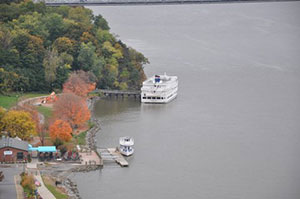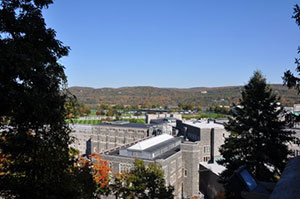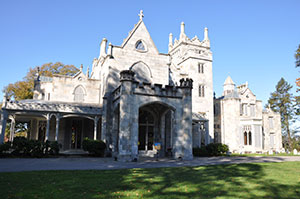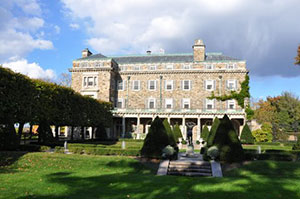

By John Karoly
Chicago, IL, USA

John Karoly
We boarded the riverboat in New York for a fall leaf trip up the Hudson River organized by the National Trust for Historic Preservation. It was a nice day with sunshine. The boat had some thirty passengers and a tour guide well equipped for a steady stream of information on the history of the river, the sites and the towns we were going to see. The history of the Hudson River Valley is among the earliest histories of this country.
We learned that the Hudson is not really a river but an estuary. The Indians' name for the river means "the river which flows both directions" according to our guide's interpretation. The flow of seawater up in high tide and down the river in low tide is considerably larger than the fresh water coming from the northern mountains. Some high, high tides have carried seawater all the way up to Troy, N.Y. When the seawater flowing up the river encounters the fresh water flowing down, the locals say the river "boils." This phenomenon can be explained by the higher density seawater flowing uphill forcing the lower density fresh water coming downstream to the top with the consequent ripple on the surface making it look like the water is boiling.
The river was named for Henry Hudson who sailed up the river from New Amsterdam in 1609. The settlements by the Dutch since the time of Peter Stuyvesant, the governor of New Netherland, have left their stamp to this day. The settlement Fort Orange was named after the royal house of the Netherlands. Stuyvesant intended to name it Beverwyck but after the surrender by the Dutch to the British in 1664, King Charles II gave the town and a large parcel of land to his brother the Duke of York and Albany. In 1686 the Governor granted a charter and recognized Albany as a city. Since that time, 74 men have served as mayor. Thirty-four of these mayors were of Dutch descent. Albany is the oldest continuing settlement in the United States.

Our Riverboat
Our first stop was Yonkers, a little way up from New York City. The town, which was at onetime fairly run-down, now is trying to rejuvenate itself. As it is in easy access to New York City, commuters are gentrifying the town. Our trip, however, went through Yonkers with the destination of Jasper Cropsey's home in Hastings-on-Hudson. Cropsey was an architect and one of the artists of the Hudson valley. He was not the best known of the Hudson River painters and artists but he had an interesting and successful career painting in New York and Europe. Having done financially well, he conducted a lifestyle which assumed his success would never end. He and his family lived very well until, almost overnight, his style of painting, the 19th century romantic style, went out of fashion and he could no longer sell his paintings. From thereon he and his family struggled. Devoted followers have preserved his last home he built on a truly lovely spot along the Hudson. We found it a very worthwhile place to visit not only to see the house and learn about him, but also to learn about the 19th century Hudson River School of painters.
One of the most historic places along the Hudson is West Point. The architecture is totally uniform, grey, homogeneous and severe. West Point trained many if not most of the famous officers of the United States Army going back to the Revolutionary War and to the Civil War. The Generals of both the North and the South were graduates of West Point.

West Point
Farther up the Hudson is the town of Kingston where the 1767 Senate House, the oldest public building in America, is located. Here the New York State Senate met in 1777. These Senate meetings were even more hazardous than the Senate meetings today. The British considered the Senate illegal and treasonous to the British Crown. Thus the meetings were held in great secrecy. The town has quite a few buildings preserved from the late 18th century; many of its inhabitants are of Dutch-descent and the traditions and history are authentically maintained.
Close to Kingston is Bard College which has a new Gehry-designed concert hall, with all its well-known stainless steel curved surfaces, in a very picturesque location along the river. Not far from Bard College is Edgewater the home of Richard Jenrette of the Donaldson, Lufkin and Jenrette investment house fame. Jenrette founded the Classical American Home Preservation Trust. This home dates from 1820 and is in an exceptional setting on the river. He purchased the home from Gore Vidal the famous American author who, at the time, lived in Rome. The original owner of the home was a daughter of a local landowner, John Livingston, who gave the land as a wedding present to his daughter Margaret in 1823. She lived there with her husband until the New York to Albany train tracks were laid directly behind the house. New York State had taken the land by eminent domain. After the death of her husband two years later, Margaret was so angry about the railroad running through her property that she sold the house and moved to London and vowed never to return to the United States. Indeed, she did not return and she is buried in London. Jenrette has built a big wall between the house and the tracks and tastefully covered the wall with vines converting the space to a rear courtyard. He furnished the house with furnishing and art which he collected and were owned by Margaret, her family and subsequent owners of the home in the nineteenth century.
The next stop on the river was Poughkeepsie where Vassar College was founded by Mr. Vassar as one of the first colleges dedicated to women's education. Vassar was and still is a fine Liberal Arts school which I have known during my college years when it was still a women's only college. Today the school is co-ed – in this case male students integrated the student body. The school houses an Art center dedicated to Hudson River School painters.
Just north of Poughkeepsie is Franklin Roosevelt's home, Springwood, and Presidential Museum in Hyde Park, N.Y. The house and museum are public property. FDR was born, raised, and lived and died in the house owned by his mother until her death. The polio-stricken President was properly accommodated in this surrounding which allowed him to hide from the public his infirmity in the era when such events could still be kept quiet by asking the press core for discretion.

Lyndhurst
Franklin Roosevelt and his cousin Theodore's ancestors on their father's side came from Holland while on their mother's side they were French Huguenots. Their original, rather unpronounceable name was changed to Roosevelt. His mother was a true matriarch who kept Franklin under close control and scrutiny. She did let him and his wife Eleanor know that Springwood was her home, no two ways about it. The Roosevelt's were land rich but otherwise not particularly wealthy. Springwood was willed to become a public property after Franklin's death. Eleanor had her own estate within the Roosevelt's Property, Val-Kill, which she built as a refuge from her mother-in-law. This estate was not open at the time of our visit as the staff was off due to the sequestration of government funds.
The house was equipped to accommodate Franklin's infirmity, but with its closed shades to protect the furnishing from the light, late 19th/early 20th century furnishings were rather more historical then attractive. Many famous personalities visited there, among them Winston Churchill, the King of England, but not the crew that filmed a movie on the life of Franklin Roosevelt, Hyde Park on the Hudson.
It was during our return trip to New York City that we were taken first to Lyndhurst, a Gothic Revival mansion which was owned by railroad magnate and robber baron Jay Gould. He bought the estate originally named Lindenhurst, named after the imported Linden trees which are still all over the very picturesque property lying along the Hudson River. Gould, a man most disliked in his time, modified the mansion in our view not in the most attractive way, but outdid himself with the furnishings and décor which were designed to impress visitors with the great wealth of its owner. Money was spent on faux marble to show that he could afford to pay artisans to paint walls which look like marble, whereas using true marble would have been less expensive. The result is a rather tastelessly furnished historical mansion located on great grounds designed in the English naturalistic-style which was maintained after Gould's death by his daughter. She returned from France where she was married to an aristocrat and upon her death she bequeathed the estate to the National Trust.

Kykuit
Our last but certainly not the least significant stop was the Rockefeller estate, Kykuit (a Dutch word which means "lookout"), in Sleeping Hallow/Tarrytown. Here good taste and great money came together to offer the finest of landscape design, mansion and interiors furnished with a timeless taste. The building and surrounding gardens were donated to the National Trust after the passing of Nelson Rockefeller. In his Will he left his interest in the Estate to the National Trust. The family negotiated the arrangement whereby the main mansion and associated gardens and buildings which belong to it are owned and administered by the National Trust while the rest of the Estate, mansions and structures were left to other family members. The main mansion houses Nelson Rockefeller's modern art collection scattered throughout. Nelson was responsible for the décor and some of the rearrangements in the building. He died unexpectedly rather young but not entirely in an undesirable way. The grounds and content are a tribute to him as a politician and governor of the State of New York.
Located in an adjacent town in a picturesque setting is the Union Church which is the Rockefeller's chapel. It is among the first non-denominational churches in the United States and is renowned for its large stained glass windows by Matisse and Chagall.
There is no question in my mind that the glory of the Hudson River Valley with its rich history and its trees in fall colors is an American experience not to be missed.




